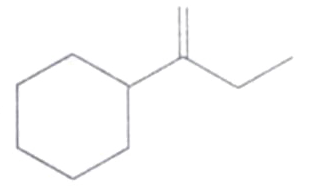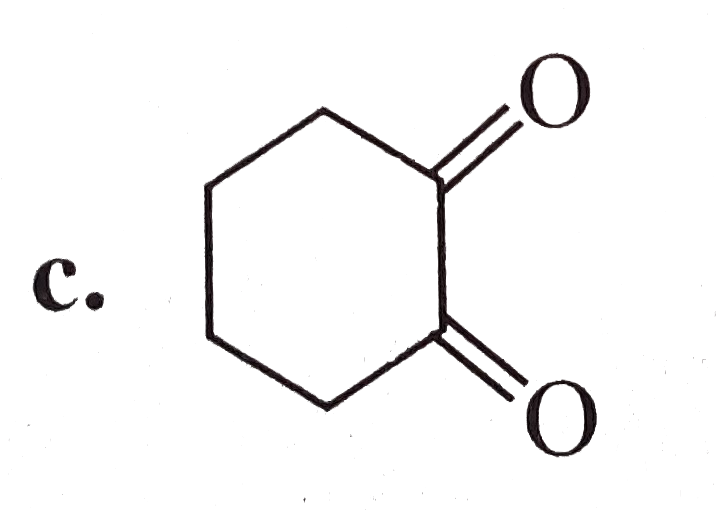Explore topic-wise InterviewSolutions in .
This section includes InterviewSolutions, each offering curated multiple-choice questions to sharpen your knowledge and support exam preparation. Choose a topic below to get started.
| 23001. |
Which of the following statement is not correct when a mixture of NaCl and K_2Cr_2O_7 is warmed with conc. H_2SO_4 ? |
|
Answer» Deep red VAPOURS are EVOLVED |
|
| 23002. |
Which of the following IUPAC names is not correctly matched? |
|
Answer»
 is 2-methylclopentanecarboxylic acid. is 2-methylclopentanecarboxylic acid.
|
|
| 23003. |
Whichof the followingcompoundis responsiblefor depletionof ozonelayer ? |
|
Answer» Freon |
|
| 23004. |
Which of the following sets of quantum number is correct for an electron in 4f orbital? |
|
Answer» n=4,L =3,m =4,s = `+ 1//2` |
|
| 23005. |
What is saponification? Write the equation to get sodium stearate by this method. |
Answer» SOLUTION :When oil or fat is heated with aqueous NAOH, sodium SALTS of fatty ACIDS (soaps) are FORMED. 
|
|
| 23006. |
Which reagent can be used to separate CH_3COCH_3 from C Cl_4 in a mixture: |
|
Answer» `NaHSO_3` |
|
| 23007. |
Which of the following complexes exhibit chirality ? |
|
Answer» `[Cr("ox")_(3)]^(3-)` |
|
| 23008. |
Two substances when separated out on the basis of their extent of adsorption by one material ,the phenomenon is : |
|
Answer» COLUMN chromatorgraphy |
|
| 23009. |
Which of the following is not the product of dehydration of |
|
Answer»

|
|
| 23010. |
Which element among the following does NOT form diatomic molecules? |
|
Answer» Argon <BR>Oxygen |
|
| 23011. |
Which of the following can exist as geometric isomers ? |
|
Answer» `ClCH_(2)C-=C CH_(3)`<BR>`ClCH_(2)-CH=CH-CH_(2)Cl` |
|
| 23012. |
Which of the following is /are polymer of formadehyde ? |
|
Answer» BAKELITE |
|
| 23013. |
What happens when bromoethane is heated with alcoholic potash ? Give equations. |
|
Answer» Solution :Bromoethane or heating with ALCOHOLIC KOH gives ethene as a MAJOR PRODUCT. `underset("Ethyl bromide")(C_(2)H_(5)-Br) underset(Delta)overset(Alc.KOH)to H-overset(H)overset(|)(C)=overset(H)overset(|)(C)+KBr+H_(2)O`) |
|
| 23014. |
Which of the following resembles dioxygen in its magnetic property |
| Answer» ANSWER :D | |
| 23015. |
Which of the following sets of ions represents the collection of isoelectronic species? |
|
Answer» `K^(+),Cl^(-),Mg^(2+),Sc^(3+)` |
|
| 23016. |
Which of the following is calcium super phosphate ? |
|
Answer» `CA(H_(2)PO_(4))_(2)H_(2)O+2CaSO_(4)2H_(2)O` |
|
| 23017. |
Which of the following statements is not correct about the characteristics of cathode rays? |
|
Answer» They start from the cathode and MOVE TOWARDS the anode. |
|
| 23018. |
Which of the following statements is not applicable to white phosphorus ? |
|
Answer» It is HIGHLY reactive |
|
| 23019. |
when two half-cells of electrode potential of E_1 and E_2 are combined to form a half cell of electrode potential E_3 , then (when n_1,n_2 " and " n_3 are no. of electrons exchanged in first second and combined half-cells: |
|
Answer» `E_3^@=E_1^@+E_2^@` |
|
| 23020. |
Which is the correct statement in case of milk? |
|
Answer» Mikis an EMULSION of FAT in water |
|
| 23021. |
Which is the last element of the series of the actinoids ? Write the electronic configuration of this elements. Comment on the possible oxidation state of this element. |
|
Answer» SOLUTION :Last actinoid = Lawrencium (Z = 103) Electronic configuration = `[RN]_(86) 5f^(14) 6^(1)7S^(2)` POSSIBLE oxidation state = +3 |
|
| 23022. |
Which reagent does not give oxygen as one of the product during oxidation with ozone? |
|
Answer» `SO_(2)` |
|
| 23023. |
Which of the following has acidic hydrogen |
|
Answer» Ethyne REACTION with SODIUM metal SHOWS that HYDROGEN is ACIDIC |
|
| 23024. |
Write the IUPAC name of the major product obtained when 2-Bromopentane reacts with alcoholic KOH. Give equation. Name the reaction. |
|
Answer» Solution :* Pent-2-ene * `{:(CH_(3)-CH_(2)-CH_(2)-CH-CH_(2)overset(OH^(-))rarrCH_(3)-CH_(2)-CH=CH-CH_(3)),("|"),(""Br):}` * Elimination reaction. |
|
| 23025. |
What is the basic difference between adsorption and absorption. |
| Answer» Solution :In ADSORPTION, the substance is concentrated only at the SURFACE and does not penetrate through the surface to the bulk of the ADSORBENT, while in absorption, the subtance is uniformly DISTRIBUTED through out the bulk of the solid. | |
| 23026. |
Which of the following compounds // complex ions would not show geometrical isomerism? |
|
Answer» `[Co(en)(SCN)_(4)]^(-)`  exist in only one form exist in only one form
|
|
| 23027. |
Which one amont the following is the most appropriate statement with respect to the atomic weight of an element ? |
|
Answer» The ATOMIC weight of an element is the sum total of the NUMBER of protons and NEUTRONS present in the atom of the element |
|
| 23028. |
Which of the following statements about benzyl chloride is incorrect? |
|
Answer» it is LESS reactive than ALKYL halides |
|
| 23029. |
Transition metals are less reactive than s-block metalsbecause of their : |
|
Answer» HIGH ionisation potential and LOW MELTING POINT |
|
| 23030. |
Discuss the reactions of aliphatic aldehydes and ketones with Hychoxyl amine |
|
Answer» HYDROGEN bonding |
|
| 23031. |
When two reactants, A and B are mixed to given products C and D, the ractin quotient Q, at the initial stages of the reaction |
|
Answer» Is ZERO |
|
| 23032. |
Which of the following alkenes does not exhibit geometrical isomerism- |
|
Answer» `FCIC=CHD` |
|
| 23033. |
Which of the following will undergo periodic oxidation? |
|
Answer» a. b. Although two (-OH) group are at adjacent POSITION but in anti (trans) position, so it does not undergo periodic oxidation. Two  group are in adjacent position, so it undergoes periodic oxidation. d. Glyxal `(underset(CH=O)overset(CH=O)|)`, two `(-CHO)`groups are in adjacent position so it undersgoes periodic oxidation. So the answer are `(a), (c )` and `(d)`. |
|
| 23034. |
When hydrated MgCl_2.6H_2O is strongly heated: |
|
Answer» MGO is formed |
|
| 23035. |
Which is order of heat of hydrogenation for the following set of molecules :- |
|
Answer» |
|
| 23036. |
When conc. H_2SO_4 was added into an unknown salt present in a test tube, a brown gas (A) was evolved. This gas intensified when copper turnings were also added into this test tube. On cooling, the gas (A) changed into a colourless gas (B). (a) Identify the gases (A) and (B). (b) Write the equations for the reactions involved. |
|
Answer» Solution :(a) GAS (A) - `NO_2 ` ( BROWN gas ) Gas (B) - `N_2O_4` ( colourless gas ). (b) `MNO_3 + H_2SO_4 to MHSO_4 + HNO_4` `Cu + HNO_3 to Cu(NO_3)_2 + 2H_2O + underset("Brown gas ")(2NO_2)` `underset((A))(2NO_2) OVERSET(" On COOLING ")to underset("(B) colourless ")(N_2O_4)` |
|
| 23037. |
The type of isomerism present in [Pt(NH_(3))_(4)][Pd(Cl)_(4)] and [Pd(NH_(3))_(4)][Pt(Cl)_(4)] is ……………… |
|
Answer» SOLVATE isomerism |
|
| 23038. |
Which one of the following processes does not involve adsorption- |
|
Answer» HETEROGENEOUS catalysis |
|
| 23039. |
What is the cell potential of mercury cell ? What are its applications ? |
| Answer» Solution :CELL potential of MERCURY cell is approximately 1.35 V. It is used in hearing AIDS and watches. | |
| 23040. |
When electron in hydrogen atom jumps to the inner most orbit, the radiation emitted belongs to , which one of the following series? |
|
Answer» BRACKETT series |
|
| 23041. |
Total stereoisomers of [Co(N_(2)O_(4))]^(-) are : |
Answer» 
|
|
| 23042. |
What is the elementary reactions? |
| Answer» SOLUTION :The REACTION taking place in a single step is an ELEMENTARY reaction. For EXAMPLE. `N_(2)(g) +O_(2)(g) to 2NO(g)` | |
| 23043. |
Two 5 molal solutions are prepared by dissolving a non-electroylete, non -volatile solute separately in the solvents X and Y. The molecular weights of the solvents are M_(x) and M_(Y), respectively where M_(X)=4/3M_(Y). The relative lowering of vapour pressure of the solution in X is "m" times that of the solution in Y. Given that the number of moles of solute is very small in comparision to that of solvent, the value of "m" is : |
|
Answer» <P>`3/4` Number of moles of `=5xx1=5` (in both in solvents) Number of moles of solvent `x=1000/(M_(x))` Number of moles of solvent `Y=1000/(M_(Y))` Relative lowering in vapour pressure is GIVEN as `(p^(@)-p_(s))/(p_(s))=(n_(2))/(n_(1))` `((p^(@)-p_(s))/(p_(s)))_("solution in X")=5/(1000/M)=(5M_(x))/1000` `((p^(@)-p_(s))/(p_(s)))_("solution in Y")=5/(1000/(M_(Y)))=(5M_(x))/1000` According to question `1/mxx(5M)/1000=(5M_(Y))/1000` `1/mxx5xx3/4M_(Y)=M_(Y)` (Given `M_(x)=3/4M_(Y)"":.m=3/4` |
|
| 23044. |
When primary amine is heated with CS_(2) in the presence of excess of mercuric chloride, it gives isothiocyanate. This reaction is called : |
|
Answer» HOFFMANN bromamide reaction |
|
| 23045. |
Which compound is not an associated liquid: |
|
Answer» `C_6H_5OH` |
|
| 23046. |
Whichof the following react with NaOH produces acid and alcohol ? |
| Answer» Answer :A | |
| 23047. |
Which substance will conduct the current in the solid state |
|
Answer» DIAMOND |
|
| 23048. |
Which one of the following statements is true for a solution ? |
|
Answer» Molarity is ALWAYS EQUAL to molality |
|
| 23049. |
Which of the given method produce Cl_(2) |
|
Answer» Electrolysis of brine `2Cl^(-) rarr Cl_(2) + 2e^(-)` ( at anode) , `2H^(+) + 2e^(-) rarr H_(2)` ( at cathode) (b) Deacon process `: 4HCL + O_(2) underset( 450^(@)C)overset( CaCl_(2))(rarr) 2Cl_(2) + 2H_(2)O` (c ) `MnO_(2) + 4HCl ("conc.")rarr MnCl_(2) + Cl_(2) + 2H_(2)O` |
|
| 23050. |
What type of forces are involved in binding of substrate to the active site of enzyme ? |
|
Answer» Solution :Drugs the catalytic action of an enzyme hold the SUBSTRATE for a chemical reaction. Active sites of enzymes holds the substrate molecules in a suitable positions, so than it can be attacked by the REAGENTS EFFECTIVELY. Substrate BIND to the active SITE of the enzymes through a variety of interactions. These forces are van der Waal's interactions, ionic bonding, hydrogen bonding or dipole-dipole interaction. |
|








